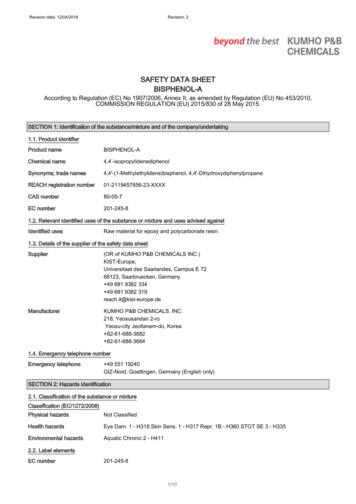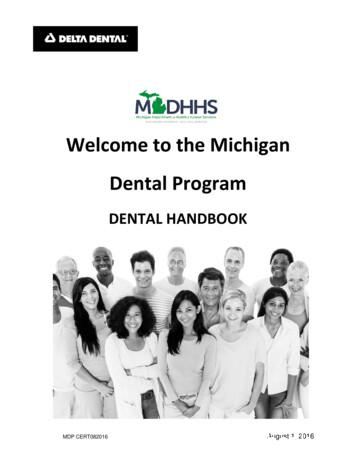Bisphenol A In Dental Materials: A Review
JSM DentistryCentralResearch ArticleCorresponding authorDr. Liang Chen, Department of Research andDevelopment, Bisco Inc, Schaumburg, USA, Tel: 1-847-5346139; Fax : 1-847-534-6139; Email: lchenchem@yahoo.comBisphenol A in DentalMaterials: A ReviewSubmitted: 21 May 2013Accepted: 07 August 2013Published: 07 August 2013Liang Chen* and Byoung In SuhCopyrightDepartment of Research and Development, Bisco Inc, Schaumburg, USA 2013 Chen and SuhOPEN ACCESSAbstractObjective: To review scientific literature on BPA in dental materials, introducingthe chemistry of BPA and its derivatives, and evaluating the BPA release and exposurefrom dental materials and the potential human health risks.Materials & methods: A search of English peer-reviewed dental literaturefrom Pub Med and MEDLINE databases was conducted, and the key words includedbisphenol A and BPA.Results & discussion: Most modern dental resin materials contain BPAderivatives (but not pure BPA), such as BisGMA, BisEMA, and BisDMA. Unlike BisGMAand BisEMA, BisDMA has an ester linkage connecting bisphenol A molecule to resin.The ester linkage of BisDMA undergoes hydrolysis reaction in saliva to convert BisDMAinto BPA. In contrast, neither BisGMA or BisEMA is converted into BPA in saliva. Thedental materials containing BisGMA or BisEMA release the amount of BPA far below(0.1%) the daily BPA intakes in people from other sources (dust, air, water, etc.), whichposes no human health risks. The dental materials containing BisDMA or polycarbonatehas not been found to pose any adverse human health risks, but more studies shouldbe conducted to evaluate the potential adverse human health effects of BisDMA andpolycarbonate-based dental materials.Keywords BPA Bisphenol A BPA-derivatives BisGMA BisEMA BisDMA Polycarbonate Dental materialsINTRODUCTIONRESULTS AND DISCUSSIONBisphenol A (BPA) has been present in many plastic polymerssince the 1960s. Studies have suggested that BPA has the potentialeffects on the brain and behavior in infants and young children[1]. In July 2012, the U.S. Food and Drug Administration (FDA)started to ban BPA-containing resins in infant feeding bottles(baby bottles) and spill-proof cups (sippy cups). Many modernresin-based dental restorative materials are composed of BPAderivatives, which has attracted attention and caused people tobe concerned about the potential human health risk of dentalresin materials.Chemistry of BPA and BPA-derivativesA lot of literature is now available investigating the BPArelease from dental restorations and its potential harm to humanhealth. This paper is a review of the scientific literature on BPA indental materials, introducing the basic chemistry of BPA and itsderivatives, and evaluating the BPA release and exposure fromdental materials and the potential human health risks.MATERIALS AND METHODSA search of English peer-reviewed dental literature fromPub Med and MEDLINE databases was conducted and limited todental journals. Key words included bisphenol A and BPA. Titles,abstracts and full articles were reviewed and evaluated.Bisphenol A (BPA) (CAS Number: 80-05-7) is an organic whitesolid compound with two hydroxyphenyl functional groups. Itis soluble in organic solvent, but almost insoluble in water. Itschemical structure is shown in Figure 1. BPA is used primarilyin the production of polycarbonate (plastic containers, waterbottles, and water pipers) and epoxy resins. More than 2 milliontons of BPA are currently produced every year [2].Pure BPA is not a component of dental products. In dentistry,the most commonly used BPA-derivatives include bisphenolA diglycidyl methacrylate (BisGMA), ethoxylated bisphenol Aglycol dimethacrylate (BisEMA), and bisphenol A dimethacrylate(BisDMA) (Figure 1). The BPA-derivatives are synthesized fromBPA, so they may contain a trace amount of (ppm or ppb level) [3]of BPA. Some BPA-derivatives with ester bond (-O-CO-) linkingBPA molecule to resin, such as BisDMA and polycarbonate, have henol Adimethacrylate in whole saliva. Dent Mater. 2002; 18: 128-35.5. Kadoma Y, Tanaka M. Acid and base-catalyzed hydrolysis of bisphenolA-related compounds. Dent Mater J. 2000; 19: 139-52.6. Lakind JS, Naiman DQ. Bisphenol A (BPA) daily intakes in the UnitedStates: Estimates from the 2003–2004 NHANES urinary BPA data.Journal of Exposure Science and Environmental Epidemiology2008;18:608–615.7. Okada H, Tokunaga T, Liu X, Takayanagi S, Matsushima A, ShimohigashiY. Direct evidence revealing structural elements essential for the highbinding ability of bisphenol A to human estrogen-related receptorgamma. Environ Health Perspect. 2008; 116: 32-38.8. vom Saal FS, Myers JP. Bisphenol A and risk of metabolic disorders.JAMA. 2008; 300: 1353-1355.9. Nadal A. Obesity: Fat from plastics? Linking bisphenol A exposure andobesity. Nat Rev Endocrinol. 2013; 9: 9-10.4/5
Chen and Suh (2013)Email: lchenchem@yahoo.comCentral10. Jones DC, Miller GW. The effects of environmental neurotoxicants onthe dopaminergic system: A possible role in drug addiction. BiochemPharmacol. 2008; 76: 569-581.11. Smith CC, Taylor HS. Xenoestrogen exposure imprints expression ofgenes (Hoxa10) required for normal uterine development. FASEB J.2007; 21: 239-246.12. Li D, Zhou Z, Qing D, He Y, Wu T, Miao M, et al. Occupational exposureto bisphenol-A (BPA) and the risk of self-reported male sexualdysfunction. Hum Reprod. 2010; 25: 519-527.13. Muñoz-de-Toro M, Markey CM, Wadia PR, Luque EH, Rubin BS,Sonnenschein C, et al. Perinatal exposure to bisphenol-A altersperipubertal mammary gland development in mice. Endocrinology.2005; 146: 4138-4147.14. Newbold RR, Jefferson WN, Padilla-Banks E. Prenatal exposure tobisphenol a at environmentally relevant doses adversely affects themurine female reproductive tract later in life. Environ Health Perspect.2009; 117: 879-885.15. Murray TJ, Maffini MV, Ucci AA, Sonnenschein C, Soto AM. Induction ofmammary gland ductal hyperplasias and carcinoma in situ followingfetal bisphenol A exposure. Reprod Toxicol. 2007; 23: 383-390.16. Ferracane JL. Resin composite--state of the art. Dent Mater. 2011; 27:29-38.17. Ferracane JL, Stansbury JW, Burke FJ. Self-adhesive resin cements- chemistry, properties and clinical considerations. J Oral Rehabil.2011; 38: 295-314.18. Manabe A, Kaneko S, Numazawa S, Itoh K, Inoue M, Hisamitsu H, et al.Detection of bisphenol-A in dental materials by gas chromatographymass spectrometry. Dent Mater J. 2000; 19: 75-86.19. Imai Y, Watanabe M, Ohsaki A. Analysis of major components andbisphenol A in commercial Bis-GMA and Bis-GMA-based resins usinghigh performance liquid chromatography. Dent Mater J. 2000; 19:263-269.20. Zimmerman-Downs JM, Shuman D, Stull SC, Ratzlaff RE. Bisphenol Ablood and saliva levels prior to and after dental sealant placement inadults. J Dent Hyg. 2010; 84: 145-150.21. Kingman A, Hyman J, Masten SA, Jayaram B, Smith C, Eichmiller F,et al. Bisphenol A and other compounds in human saliva and urineassociated with the placement of composite restorations. J Am DentAssoc. 2012; 143: 1292-302.22. Joskow R, Barr DB, Barr JR, Calafat AM, Needham LL, Rubin C. Exposureto bisphenol A from bis-glycidyl dimethacrylate-based dental sealants.J Am Dent Assoc. 2006; 137: 353-362.23. Chung SY, Kwon H, Choi YH, Karmaus W, Merchant AT, Song KB, et al.Dental composite fillings and bisphenol A among children: a survey inSouth Korea. Int Dent J. 2012; 62: 65-69.24. Fung EY, Ewoldsen NO, St Germain HA Jr, Marx DB, Miaw CL, Siew C,et al. Pharmacokinetics of bisphenol A released from a dental sealant.J Am Dent Assoc. 2000; 131: 51-58.25. Arenholt-Bindslev D, Breinholt V, Preiss A, Schmalz G. Time-relatedbisphenol-A content and estrogenic activity in saliva samples collectedin relation to placement of fissure sealants. Clin Oral Investig. 1999; 3:120-125.26. Olea N, Pulgar R, Pérez P, Olea-Serrano F, Rivas A, Novillo-Fertrell A,et al. Estrogenicity of resin-based composites and sealants used indentistry. Environ Health Perspect. 1996; 104: 298-305.27. Kloukos D, Pandis N, Eliades T. Bisphenol-A and residual monomerleaching from orthodontic adhesive resins and polycarbonatebrackets: a systematic review. Am J Orthod Dentofacial Orthop. 2013;143: S104-S112.e2.28. Watanabe M. Degradation and formation of bisphenol A inpolycarbonate used in dentistry. J Med Dent Sci. 2004; 51: 1-6.29. Kang YG, Kim JY, Kim J, Won PJ, Nam JH. Release of bisphenol A fromresin composite used to bond orthodontic lingual retainers. Am JOrthod Dentofacial Orthop. 2011; 140: 779-789.30. Tanaka M, Kawamoto T, Matsumoto H. Distribution of 14C-bisphenolA in pregnant and newborn mice. Dent Mater. 2010; 26: 181-187.31. Johnson R, Anderson D, Bakko D. Bisphenol-A exposure from dentalsealants is minimal and does not cause increased morbidity ormortality (UT CAT# 2313). Tex Dent J. 2013; 130: 214.32. Watanabe M, Hase T, Imai Y. Change in the bisphenol A content in apolycarbonate orthodontic bracket and its leaching characteristics inwater. Dent Mater J. 2001; 20:353-358.33. Imai Y, Komabayashi T. Elution of bisphenol A from composite resin: amodel experiment. Dent Mater J. 2000; 19: 133-138.34. ADA Council on Scientific Affairs position statement: estrogeniceffects of bisphenol A lacking in dental sealants. J Gt Houst Dent Soc.1998; 70: 11.35. Eliades T, Hiskia A, Eliades G, Athanasiou AE. Assessment ofbisphenol-A release from orthodontic adhesives. Am J OrthodDentofacial Orthop. 2007; 131: 72-75.36. Suzuki K, Ishikawa K, Sugiyama K, Furuta H, Nishimura F. Contentand release of bisphenol A from polycarbonate dental products. DentMater J. 200; 19:389-395.37. Eliades T, Voutsa D, Sifakakis I, Makou M, Katsaros C. Release ofbisphenol-A from a light-cured adhesive bonded to lingual fixedretainers. Am J Orthod Dentofacial Orthop. 2011; 139: 192-195.Cite this articleChen L, Suh BI (2013) Bisphenol A in Dental Materials: A Review. JSM Dent 1: 1004.JSM Dent 1: 1004 (2013)5/5
the most commonly used BPA-derivatives include bisphenol . A diglycidyl methacrylate (BisGMA), ethoxylated bisphenol A glycol dimethacrylate (BisEMA), and bisphenol A dimethacrylate (BisDMA) (Figure 1). The BPA-derivatives are synthesized from BPA, so they may
such as bisphenol A diallyl ether, diallyl bisphenol A or bisphenol S diallyl ether [16]. The starting compound bisphenol A is used in the manufacturing of plastic food and paper consumer products [17]. However, bisphenol A is considered to cause endocrine,
BISPHENOL-A Initial boiling point and range 360 C @ 1013 hPa Bisphenol A shows decomposition at the boiling point. Flash point 227 C at 1013 hPa C CC (Closed cup). Evaporation rate Not available. Vapour pressure 0.000000412 Pa @ C Relative density 1.2 g/cm3 @ at 25 C Solubility(ies) 0.0300 @ C Partition coefficient log Pow: 3.4 at 21.5 CFile Size: 293KBPage Count: 10Explore furtherBisphenol A Solid Epoxy Resins Business & Products DIC .www.dic-global.comRedox Pty Ltd - Safety Data Sheet Bisphenol A, Epoxy Resin .redox.comSAFETY DATA SHEET EPOXY RESINcountertopepoxy.comMATERIAL SAFETY DATA ShEET POLYCARBONATEpolymerplastics.comRecommended to you based on what's popular Feedback
DENTAL SCIENCES 1 Chapter 1 I Dental Assisting— The Profession 3 The Career of Dental Assisting 4 Employment for the Dental Assistant 4 The Dental Team 6 Dental Jurisprudence and Ethics 12 Dental Practice Act 12 State Board of Dentistry 12 The Dentist, the Dental Assistant, and the Law 13 Standard of Care 13 Dental Records 14 Ethics 14
Cigna Dental Care DMO Patient Charge Schedules 887394 09/15 CDT 2016 Covered under Procedure Code1 Dental Description and Nomenclature Cigna Dental 01 and 02 PCS Cigna Dental 03 PCS Cigna Dental 04 PCS Cigna Dental 05 PCS Cigna Dental 06 PCS Cigna Dental 07 PCS Cigna Dental 08 PCS Chair Time Per Y/N Minutes Code # (if different) Y/N Code # (if .
3.1.2.9 Synthesis of Propoxylated Bisphenol A dimethacrylate 57 3.1.2.10 Purification of Propoxylated Bisphenol A dimethacrylate 60 3.1.2.11 Synthesis of Propoxylated 6F dimethacrylate 60 3.1.2.12 Synthesis of Ethoxylated Bisphenol A dimethacrylate 61 3.1.2.13 Synthesis of Ethoxyla
is a detailed list of dental services provided by a dental office and given to Delta Dental for payment. Delta Dental means Delta Dental Plan of Michigan, Inc., a service provider for dental benefits under the Michigan Dental Program. Delta Dental ID Card is a permanent (not monthly) card. We send
Mid-level dental providers, variously referred to as dental therapists, dental health aide therapists and registered or licensed dental practitioners, work as part of the dental team to provide preventive and routine dental services, such as cleanings and fillings. Similar to how nurse practitioners work alongside physicians, mid-level dental .
The HRMS user’s guides are available online. All Oracle Applications user’s guides are available online, in both HTML and Adobe Acrobat format. Most other Oracle Applications documentation is available in Adobe Acrobat format. The HTML version of the HRMS user’s guides are optimized for























